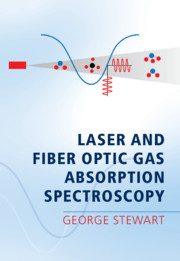Book contents
- Laser and Fiber Optic Gas Absorption Spectroscopy
- Laser and Fiber Optic Gas Absorption Spectroscopy
- Copyright page
- Dedication
- Contents
- Preface
- 1 Absorption Spectroscopy of Gases
- 2 DFB Lasers for Near-IR Spectroscopy
- 3 Wavelength Modulation Spectroscopy with DFB Lasers
- 4 Photoacoustic Spectroscopy with DFB Sources
- 5 Design and Application of DFB Laser Systems and Optical Fibre Networks for Near-IR Gas Spectroscopy
- 6 Principles of Fibre Amplifiers and Lasers for Near-IR Spectroscopy
- 7 Applications of Fibre Amplifiers and Lasers in Spectroscopy
- 8 Mid-IR Systems and the Future of Gas Absorption Spectroscopy
- Index
- References
4 - Photoacoustic Spectroscopy with DFB Sources
Published online by Cambridge University Press: 07 April 2021
- Laser and Fiber Optic Gas Absorption Spectroscopy
- Laser and Fiber Optic Gas Absorption Spectroscopy
- Copyright page
- Dedication
- Contents
- Preface
- 1 Absorption Spectroscopy of Gases
- 2 DFB Lasers for Near-IR Spectroscopy
- 3 Wavelength Modulation Spectroscopy with DFB Lasers
- 4 Photoacoustic Spectroscopy with DFB Sources
- 5 Design and Application of DFB Laser Systems and Optical Fibre Networks for Near-IR Gas Spectroscopy
- 6 Principles of Fibre Amplifiers and Lasers for Near-IR Spectroscopy
- 7 Applications of Fibre Amplifiers and Lasers in Spectroscopy
- 8 Mid-IR Systems and the Future of Gas Absorption Spectroscopy
- Index
- References
Summary
The principles of photoacoustic spectroscopy and the acoustic wave equation are introduced for describing the acoustic waves generated from a modulated heat source. Acoustic resonant cells for signal enhancement are considered in detail with a full mathematical description of the resonant modes. Analytical expressions are derived for the amplitude of the acoustic modes generated by excitation of a gas with a modulated DFB laser, describing the coupling of the harmonics from the wavelength and intensity modulation to the acoustic modes.Conditions for the selective excitation of longitudinal, azimuthal and radial modes by the laser beam are explained in relation to the overlap factor between the acoustic mode profile and the beam profile.Expressions are given for the Q-factor of the cell and how cell dimensions may be chosen to optimise the performance. Calibration and sensitivity issues are discussed with examples given of typical photoacoustic cells in bulk or miniaturised form and the expected signal output at the microphone. The technique of quartz-enhanced photoacoustic spectroscopy (QEPAS) is also briefly reviewed as an alternative to the use of photoacoustic cells.
Keywords
- Type
- Chapter
- Information
- Laser and Fiber Optic Gas Absorption Spectroscopy , pp. 85 - 110Publisher: Cambridge University PressPrint publication year: 2021

